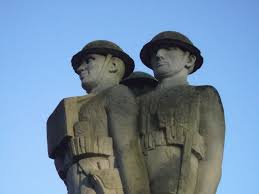
The Golden Age of American Animation
The Golden Age of American Animation was from 1928-1972. This was an exciting time for entertainment. Here we move out of the silent era of cartoons and animation and move into a much more interactive experience. Many childhood favorites were born during this time to the likes of Porky Pig, Casper the Friendly Ghost, Betty Boop, Daffy Duck, and so many others that we grew up with. This was also the time that long, full-length animation came to life on the big screen. Even though this era began in the early modern age of art, I wanted to connect with the later years of this Golden Age of American Animation and what it looked like during War World ll. The sound in animation steered Americans away from their radios, and into the world of television. From the use of orchestras to characters having the ability to speak, animation opened up an entirely new, and an entertaining can of worms. We are now open to many different genres of art. Sketching, movie making, directing, producing…so many new ways to creatively express yourself as an artist emerged during this time. In this blog, we will look at some famous directors and producers that evoked patriotism during War World ll.
Animation during this time was used for company training, military training, and for political campaigning. Movies like Fifth Column Mouse, Chicken Little, Der Feurer’s Face, and Victory Through Air Power all played important propaganda roles during this era. Animation was also a non-threatening way that the government found to use as propaganda for the war. Bugs Bunny Bond Rally is a cartoon that Americans could see Bugs Bunny dancing and singing about war bonds. Many characters during this time were depicted doing their part. Scrap Happy Daffy was a short film depicting Daffy Duck donating scrap metal for the war effort. Out of the Frying Pan Into the Firing Line is a short movie where Pluto and Minnie Mouse are encouraging Americans to recycle their kitchen grease so the government could make it into explosives. Donald Duck does his part in reminding citizens of the importance of paying their taxes during wartime in Spirit of ’43.
Walt Disney


Produced by Walt Disney, Der Fuehrer’s Face was released in 1943. This was one of many American animated anti-nazi propaganda shorts created during War World ll. This is the original theatrical poster produced to advertise the short film. It was shown in movie theaters as a means to sell war bonds. It is an 8-minute movie and created with Technicolor. There was a large animation team for this project because, during this time, it was such a large process to create an animated film. It began with creating claymations that were studied by the artists for movement and lifelike characteristics, to then in-turn sketch each scene, and lay them into cells, and then into a film. Elements like shading, movement, and even the texture really makes these pieces come to life in an animated way.
This second picture is another short produced by Walt Disney. It’s titled Donald’s Decision. It was released in 1942 and ran for 3 minutes and 35 seconds. The color process was also Technicolor. This film was actually released first in Canada. The Canadian government was also urging their citizens to purchase war bonds in support of the war. Disney felt a huge financial impact from the war. With the loss of the European market, due to the war, Disney had to be creative and reach out to other markets. I love how simple the use of shadow is in this frame. It was thoughtfully done. The multiple uses of color and tone are impactful, drawing the audience the gold-haloed duck with the piggy bank (Donald’s conscience). The amount of three-dimensional work is apparent and appreciated throughout the short.
Bob Clampett


Any Bonds Today is a short film directed by Bob Clampett. It starred Warner Brother’s Bugs Bunny and other favorites, but oddly enough, not considered a Looney Tunes or Merrie Melodies production. Just a spin-off of them. The song was written by Irving Berlin and this was used as a propaganda piece in War World ll (1942) for Americans to purchase war bonds. This was a 90-second film short (what we would now call commercials) and started as a sketch, then processed onto cells, then film. It debuted 8 days after the attack on Pearl Harbor and was done at no charge as an act of patriotism. This type of propaganda was played in movie theaters. Ushers would collect money for the war efforts throughout the movie. Here you get to see some solid three-dimensional sketch work. The contrast between the main characters in the front from the gloomy, war-torn background is very apparent. The exaggeration used in the faces really allows for some personality to come out in an animated way. What a fun time in history for animation!
Draftee Daffy was a 7-minute cartoon in which he is feeling very patriotic and gets a call from the draft office stating they have a letter for him. As the clip unfolds, so does the excitement of going to war. Daffey then is doing what he can to avoid the delivery of the draft letter. It was fun to watch and can be found here. The release date for this cartoon was 1945. It was directed by Bob Clampett. It was produced in technicolor and is part of a collection that was later released in 1989 titled Bugs and Daffy: The Wartime Cartoons. There were so many fabulous cartoons about patriotism and War World ll directed by Bob Clampett during this time. It was really interesting to see the connection between art and war in an animated manner vs. canvas or architecture. I love the contrast between the to pieces here. In just a matter of 3 years, color and animation had come a very long way. So many more elements are introduced here with different shades, lines, and contrast.
Friz Freleng

 \
\
The Fifth-Column Mouse was directed by Friz Freleng. This is a 7-minute movie created in Technicolor. It was released in 1943. It was about a group of mice that are banding together against a cat that was threatening their way of life. A mouse gets captured and the cat convinces him that he won’t hurt any of the other mice and encourages him to go tell the others of his promise. This was part of the “loose lips sink ships” propaganda used by all sides relying on that the people would believe “fake news” to help with their war tactics. It was created in reference to War World ll. The cat is the Axis, and the mice the Allies. American directors and producers found many different ways to reach their target audiences in these propaganda pieces. Shadow, shading, and even the tone really bring life to this cell. All eyes are drawn to the main character.
Private SNAFU (U.S. Army acronym standing for Situation Normal: All Fucked Up), was a short film (4 minutes), directed by Friz Freleng between 1943-1946. Pvt. SNAFU was used as a training movie for incoming military members. Pvt. SNAFU did everything that a soldier should never do. He had loose lips, and would often tell about troop movement. Again, using animation to meet your target audience, many of the younger recruits were illiterate, and this was a way to show them what not to do as well as build literacy skills. Pvt. SNAFU cartoons were at one point a military secret and only used for training. They were considered classified government documents. Another fabulous use of three-dimensional art. The use of line and shading really creates a realistic animated character.
Works Cited
“World War II and American Animation.” Wikipedia, Wikimedia Foundation, 17 June 2018, en.wikipedia.org/wiki/World_War_II_and_American_animation?scrlybrkr=201a02e4.
“Der Fuehrer’s Face.” Wikipedia, Wikimedia Foundation, 8 Oct. 2018, en.wikipedia.org/wiki/Der_Fuehrer%27s_Face.
“Donald’s Decision.” IMDb, IMDb.com, www.imdb.com/title/tt0167901/mediaviewer/rm4211191808.
“Donald’s Decision.” Wikipedia, Wikimedia Foundation, 6 Nov. 2018, en.wikipedia.org/wiki/Donald%27s_Decision.
Storozynski, Alex. “FROM WARNER BROTHERS… Bugs Bunny CHAPTER 137.” Nydailynews.com, New York Daily News, 9 Aug. 2002, www.nydailynews.com/archives/news/warner-brothers-bugs-bunny-chapter-137-article-1.505422.
“Old Banned Bugs Bunny U.S War Bonds Commercial from World War 2.” YouTube, YouTube, 16 Apr. 2009, www.youtube.com/watch?v=a1Scr3TLcm4.
“Any Bonds Today?” Wikipedia, Wikimedia Foundation, 1 Oct. 2018, en.wikipedia.org/wiki/Any_Bonds_Today%3F?scrlybrkr=201a02e4.
“Draftee Daffy.” IMDb, IMDb.com, www.imdb.com/title/tt0037659/mediaviewer/rm1301166592.
“Draftee Daffy.” Wikipedia, Wikimedia Foundation, 27 Aug. 2018, en.wikipedia.org/wiki/Draftee_Daffy?scrlybrkr=201a02e4.
“File:Fifthcolumnmouse.jpg.” Wikipedia, Wikimedia Foundation, 19 Apr. 2018, en.wikipedia.org/wiki/The_Fifth-Column_Mouse#/media/File:Fifthcolumnmouse.jpg.
“Private Snafu.” Wikipedia, Wikimedia Foundation, 24 Oct. 2018, en.wikipedia.org/wiki/Private_Snafu.
“This WWII Cartoon Taught Soldiers How to Avoid Certain Death.” History.com, A&E Television Networks, www.history.com/news/wwii-propaganda-private-snafu-flashback.












 \
\

















 This picture was taken by Gary Williams, overlooking the Homer Spit in Homer, Alaska (December 5, 2011). There are many elements found in this piece that inspire awe and emotions. The dismal lighting brings familiarity to anyone who has had the esteemed privilege of visiting the Alaskan coast. You can see how the diversity of the soft and harsh colors mingle with one another with blacks, whites and grays inviting the viewer to observe slants and balance in the photo. The darker elements draw the viewer’s eye to where the water meets the land. This allows the freedom for the observer to scan the entire composition of work. The natural landscape provides texture to this piece by accentuating gray skies, deep crevasses and unsteady tides. It affords the viewer the suggestion of movement in the tides, and rigidity in the clouds above the bay. The contrasting feel of the snowy caps, and darkened waves are very visually stimulating. The shapes naturally formed in the picture are clearly defined. There is an organic line that that is present throughout this photograph. It follows the ridge line, to the water, to the lands end of the Spit. I feel there is adequate and appropriate space employed to emphasize the sky, the land, and the sea. This provides harmony amongst the elements and genuinely kept me absorbed in my utopian affair.
This picture was taken by Gary Williams, overlooking the Homer Spit in Homer, Alaska (December 5, 2011). There are many elements found in this piece that inspire awe and emotions. The dismal lighting brings familiarity to anyone who has had the esteemed privilege of visiting the Alaskan coast. You can see how the diversity of the soft and harsh colors mingle with one another with blacks, whites and grays inviting the viewer to observe slants and balance in the photo. The darker elements draw the viewer’s eye to where the water meets the land. This allows the freedom for the observer to scan the entire composition of work. The natural landscape provides texture to this piece by accentuating gray skies, deep crevasses and unsteady tides. It affords the viewer the suggestion of movement in the tides, and rigidity in the clouds above the bay. The contrasting feel of the snowy caps, and darkened waves are very visually stimulating. The shapes naturally formed in the picture are clearly defined. There is an organic line that that is present throughout this photograph. It follows the ridge line, to the water, to the lands end of the Spit. I feel there is adequate and appropriate space employed to emphasize the sky, the land, and the sea. This provides harmony amongst the elements and genuinely kept me absorbed in my utopian affair.